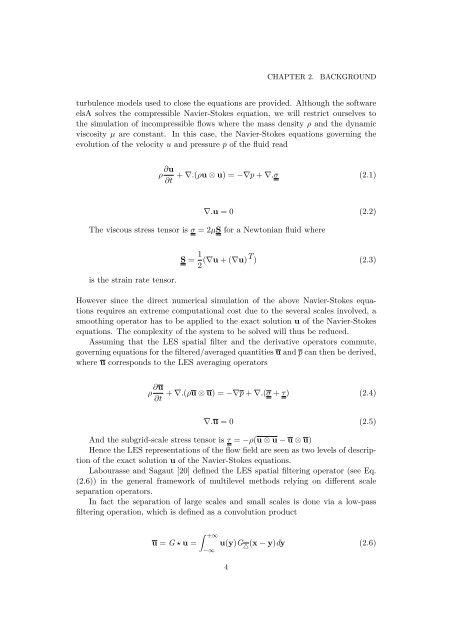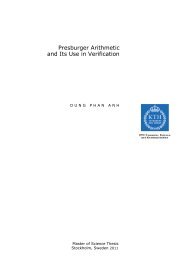Synthetic Inflow Condition for Large Eddy Simulation (Synthetic - KTH
Synthetic Inflow Condition for Large Eddy Simulation (Synthetic - KTH
Synthetic Inflow Condition for Large Eddy Simulation (Synthetic - KTH
You also want an ePaper? Increase the reach of your titles
YUMPU automatically turns print PDFs into web optimized ePapers that Google loves.
CHAPTER 2. BACKGROUND<br />
turbulence models used to close the equations are provided. Although the software<br />
elsA solves the compressible Navier-Stokes equation, we will restrict ourselves to<br />
the simulation of incompressible flows where the mass density ρ and the dynamic<br />
viscosity µ are constant. In this case, the Navier-Stokes equations governing the<br />
evolution of the velocity u and pressure p of the fluid read<br />
ρ ∂u<br />
∂t<br />
+ ∇.(ρu ⊗ u) = −∇p + ∇.σ (2.1)<br />
∇.u = 0 (2.2)<br />
The viscous stress tensor is σ = 2µS <strong>for</strong> a Newtonian fluid where<br />
is the strain rate tensor.<br />
S = 1<br />
2 (∇u + (∇u)T ) (2.3)<br />
However since the direct numerical simulation of the above Navier-Stokes equations<br />
requires an extreme computational cost due to the several scales involved, a<br />
smoothing operator has to be applied to the exact solution u of the Navier-Stokes<br />
equations. The complexity of the system to be solved will thus be reduced.<br />
Assuming that the LES spatial filter and the derivative operators commute,<br />
governing equations <strong>for</strong> the filtered/averaged quantities u and p can then be derived,<br />
where u corresponds to the LES averaging operators<br />
ρ ∂u<br />
∂t<br />
+ ∇.(ρu ⊗ u) = −∇p + ∇.(σ + τ) (2.4)<br />
∇.u = 0 (2.5)<br />
And the subgrid-scale stress tensor is τ = −ρ(u ⊗ u − u ⊗ u)<br />
Hence the LES representations of the flow field are seen as two levels of description<br />
of the exact solution u of the Navier-Stokes equations.<br />
Labourasse and Sagaut [20] defined the LES spatial filtering operator (see Eq.<br />
(2.6)) in the general framework of multilevel methods relying on different scale<br />
separation operators.<br />
In fact the separation of large scales and small scales is done via a low-pass<br />
filtering operation, which is defined as a convolution product<br />
� +∞<br />
u = G ⋆ u = u(y)G△ (x − y)dy (2.6)<br />
−∞<br />
4

















